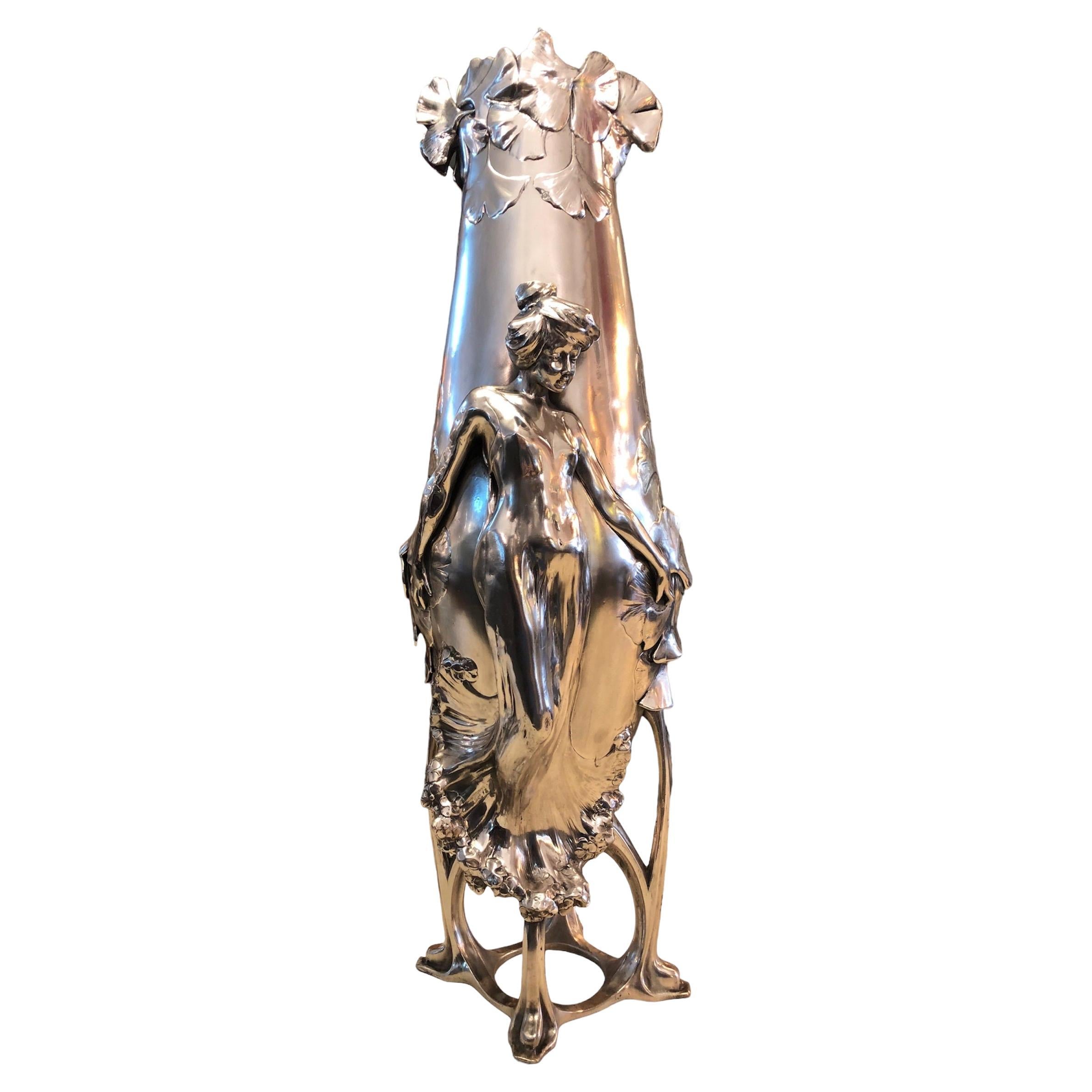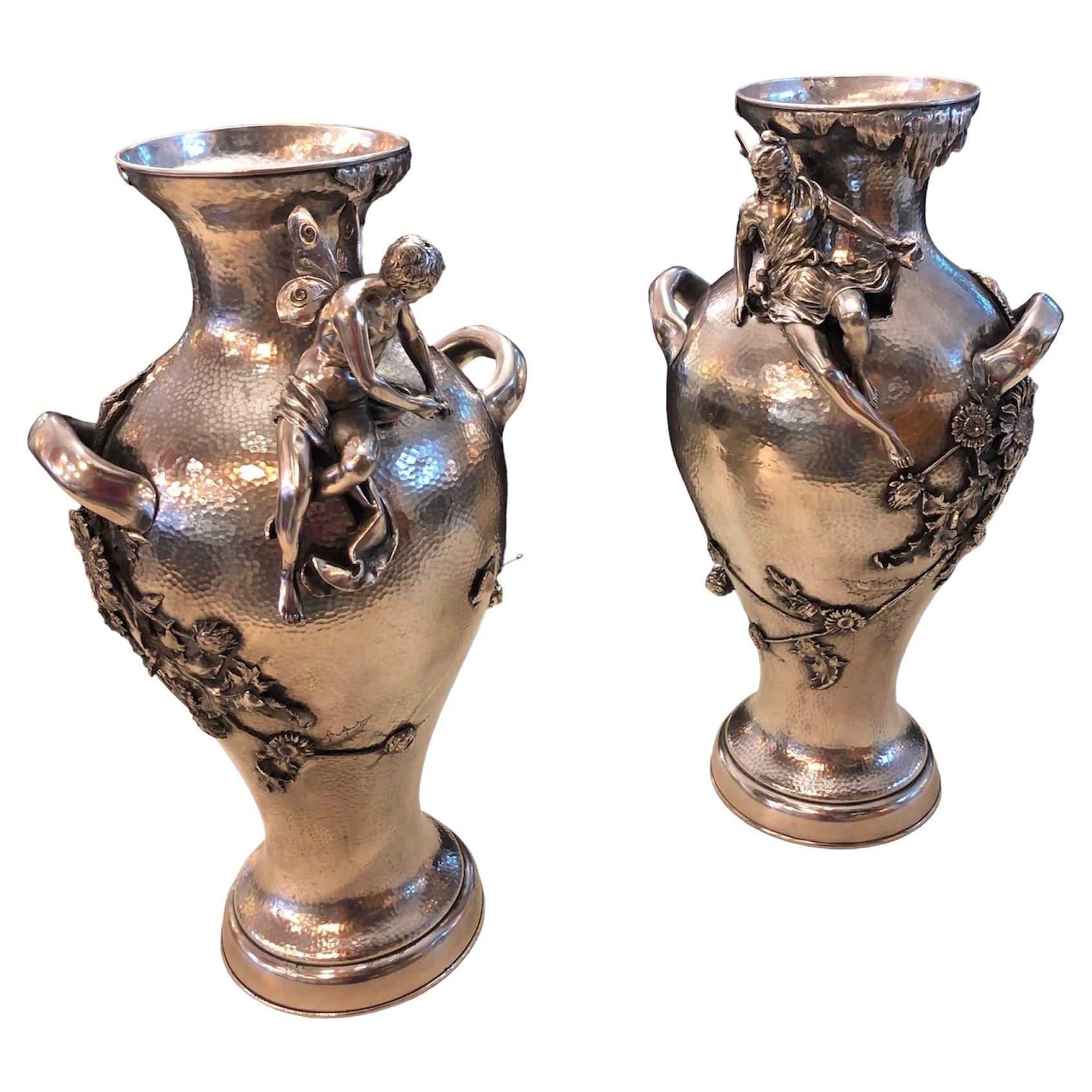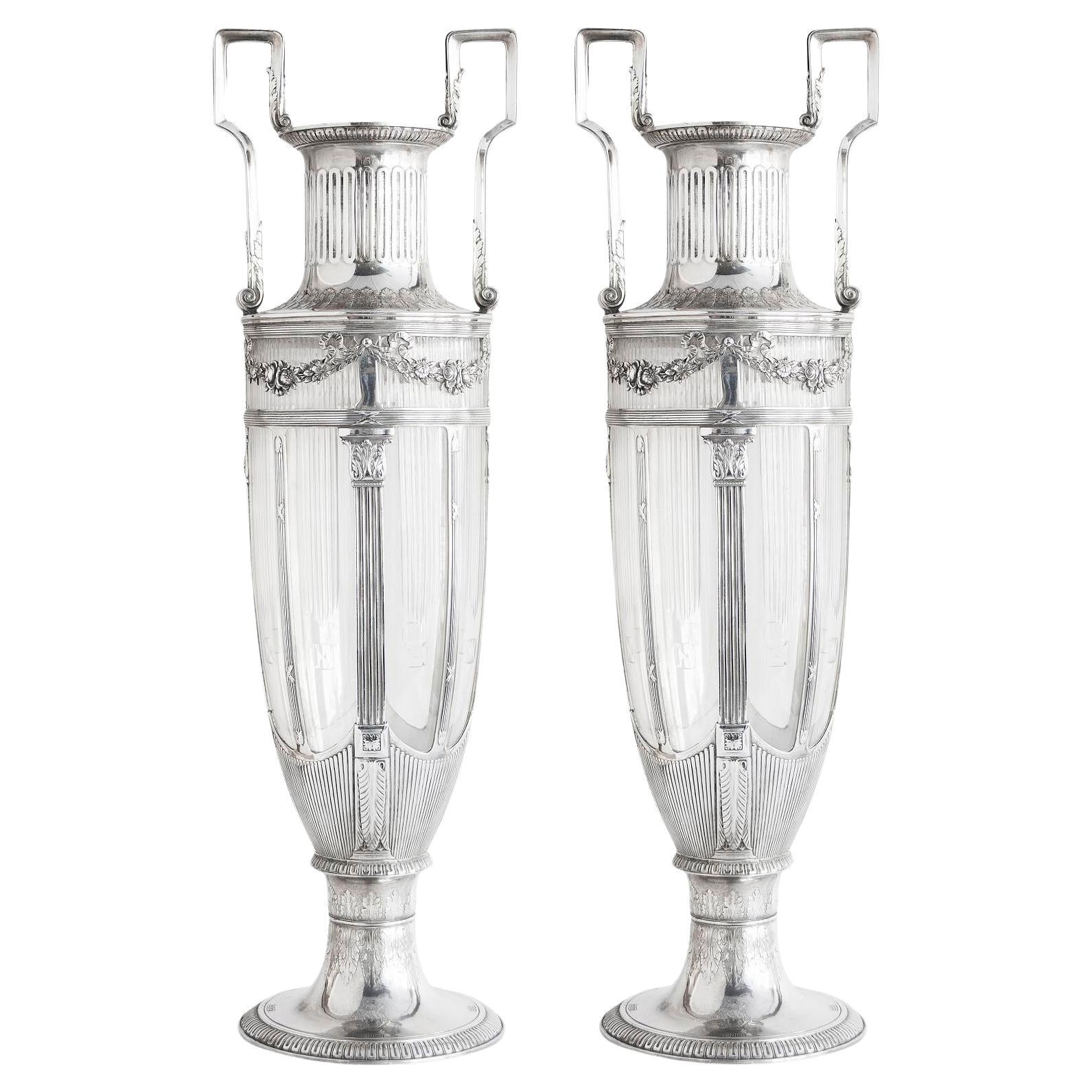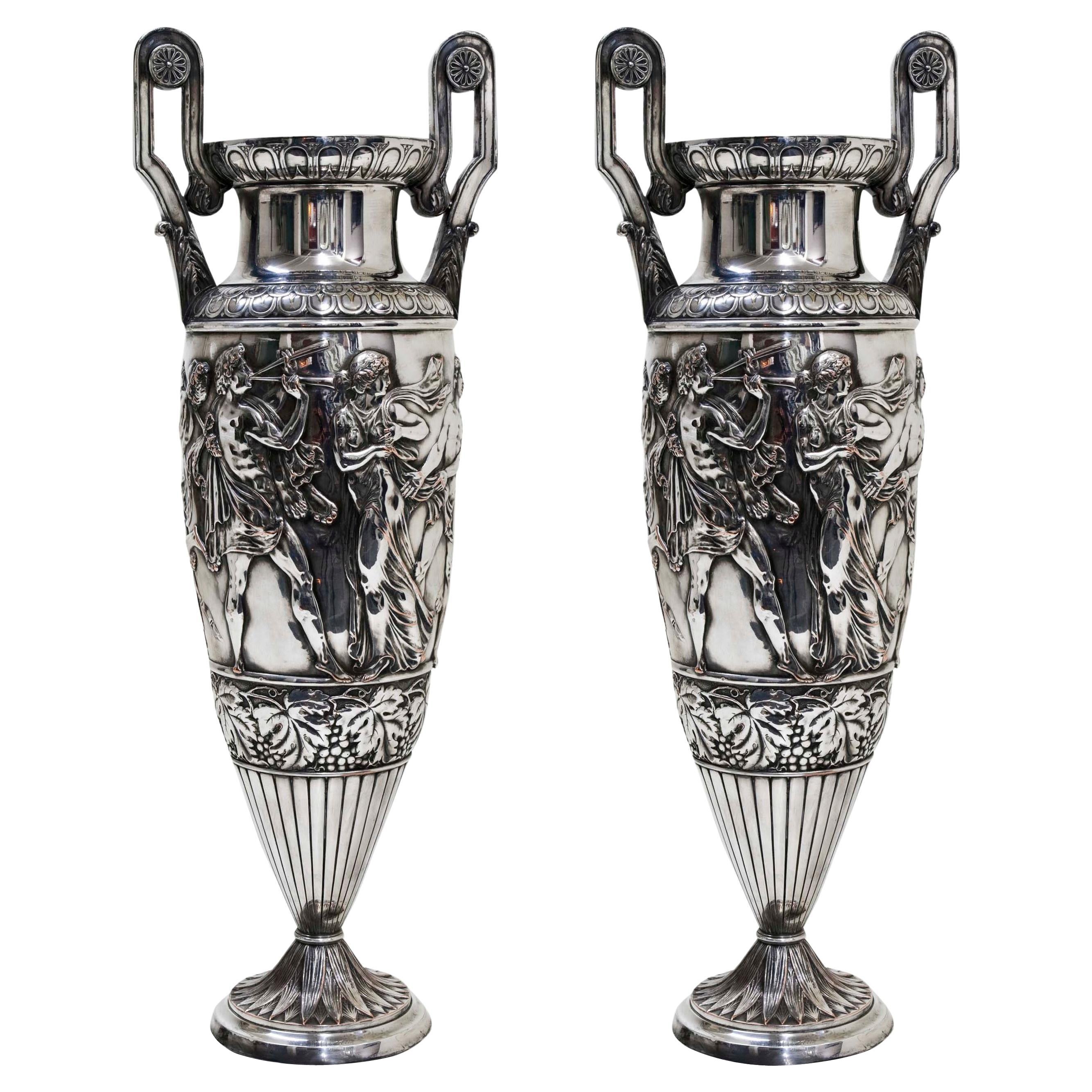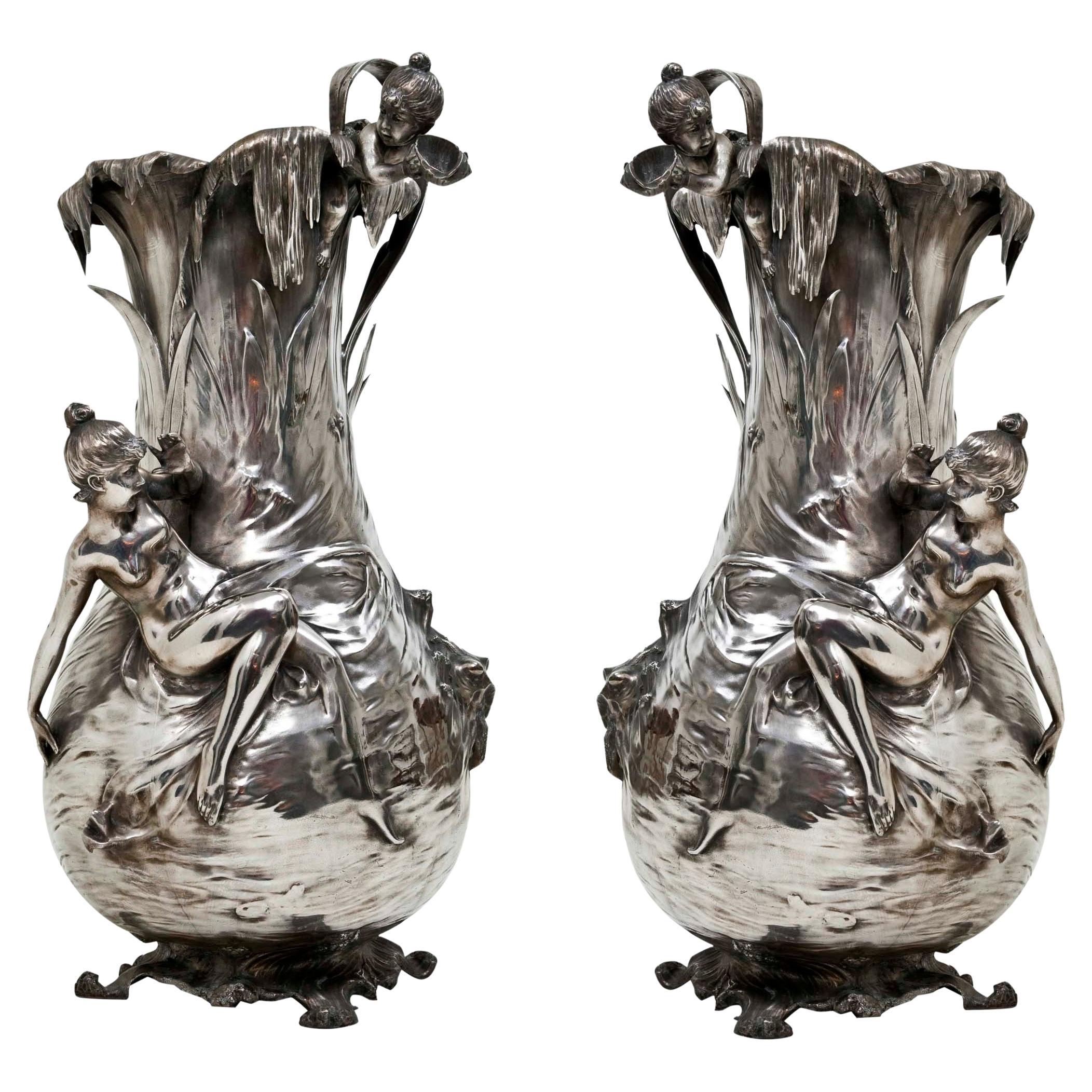Items Similar to Big Vase Orivit, German, 1906 in Silver, Art Nouveau, Sign, Orivit
Video Loading
Want more images or videos?
Request additional images or videos from the seller
1 of 21
Big Vase Orivit, German, 1906 in Silver, Art Nouveau, Sign, Orivit
About the Item
Vase Orivit
Signs:
Orivit
In 1905, WMF acquired a majority stake in the company that manufactures Orivit AG under the name "Orivit".
Country: Germany
Materials: silver plated
Several of the WMF objects can be seen in museums.
We have specialized in the sale of Art Deco and Art Nouveau and Vintage styles since 1982.If you have any questions we are at your disposal.
Pushing the button that reads 'View All From Seller'. And you can see more objects to the style for sale.
WMF (Wurttembergische Metallwarenfabrik)
Electro- Wurtemberg Plate Company in Geislingen, Germany, internationally known today as 'WMF' initials of the company Württembergische Metallwarenfabrik was founded in 1853 with 16 workers. Under the direction of Albert Mayer was influenced by Art Nouveau style. In 1914, opening factories in Germany, Poland and Austria. The origins of the firm WMF were modest, and is a lasting tribute to the vision of Daniel Straub. The first catalogs appeared in 1856-1859. The products were made of silver metal and glass among his works are candle holders, planters, punch bowls, card, flower, fruit and cutlery among others. The company was honored with several awards and international success, heralded a period of further Expansion. The German Emperor Wilhelm II presented a small museum at Harvard University. In 1905, WMF acquired a majority stake in the company that manufactures Orivit AG under the name "Orivit".
Why are there so many antiques in Argentina?
In the 1880 – 1940 there was a grate wave of immigration encouraged by the periods of war that were taking place.
1st World War took place between 1914 and 1918
2nd World War took place between 1939 and 1945
The immigrants options were New York or Buenos Aires. Tickets were cheap and in Buenos Aires they were welcomed with open arms, as it was a country where everything was still to be done.
Argentina was the country of new opportunities, labour was needed and religious freedom was assured, in many cases the of the family travel first until they were settled and then the rest of the family members join them.
In the immigrant museum “Ellis Island Immigrant Building” in New York you can se the promotional posters of the boats that would take them to a new life.
Between the years 1895 and 1896, Argentina had the highest DGP (gross domestic product) per capita in the world according to the Maddison Historical Statistics index, this situation arose due to the large amount of food being exported to European countries, which were at war.
The Argentinean ships left the port of Buenos Aires with food, but they returned with furniture, clothes and construction elements, (it´s common to see this the old buildings of the historic neighbourhood of San Telmo, the beams with the inscription “Made in England)”, as well as many markets that were built in Buenos Aires, such us the San Telmo Market, whose structure was brought by ship and afterwards assembled in 900 Defensa Street.
With the great influence of European immigrants living in the country, the children of the upper classes travelled to study in France, resulting in the inauguration of “La Maison Argentinienne”, on 27th of June 1928, in the international city of Paris, which hosted many Argentinians that were studying in Frace.
It´s the fourth house to be built after France, Canada and Belgium, being the first Spanish-speaking one. Still in place today (17 Bd Jourdan, 75014, Paris, France). Many of the children of these wealthy families who attended international art exhibitions, museums and art courses abroad, took a keen interest in the European style. This is why Buenos Aires was at the time referred as “The Paris of South America”.
Between the years 1890 and 1920 more than a hundred Palaces were built on Alvear Avenue the most exclusive avenue in Buenos Aires. Today some of these palaces have been transformed into museums, hotels and embassies.
In the year 1936, the Kavanagh building was inaugurated, it was the tallest reinforced concrete building in South America.
During 1994 the American Society of Civil Engineers distinguished it as an “international engineering milestone”, and it´s now considered a World Heritage of Modern Architecture.
At the time was common to hire foreign architects such as Le Corbusier, who visited Buenos Aires/Argentina in 1929 and in 1948 he drew up the blueprints for a house built in La Plata City (which was declared a World Heritage Site).
In 1947, the Hungarian architect Marcelo Breuer designed “Parador Ariston” in the seaside city of Mar del Plata. After an Argentinean student at Harvard University convinced him to come to Argentina. He worked on an urban development project in the Casa Amarilla, area of La Boca.
The Ukrainian architect, Vladimiro Acosta, arrives in Argentina in 1928 and worked as an architect until que moved to Brazil.
Antonio Bonet, a Spanish architect who worked with Le Corbusier in Paris, arrives in Argentina in 1937, where he carried out several architectural works and in 1938 designs the well-known BFK chair.
Andres Kálnay, of Hungarian origin, made around 120 architectural masterpieces, among which the former Munich brewery stands out, he even made the furniture’s design.
The German architect, Walter Gropius, director of the Bauhaus, lived in Argentina, where he wrote articles for “Sur” magazine and founded in Buenos Aires, an architectural firm with Franz Möller, who was also an architect, where he built two houses.
At the same time several famous designers decided to immigrate to Argentina, among them we can find the well-known French designer, Jean-Michel Frank, who arrived in the country in 1940 and also worked for the Rockefeller family.
Special pieces were made, which were sold exclusively in the country, such as the well-known German company “WMF”, who sold their products by catalogue, which were chosen by the ladies of High Society in the list of wedding gifts, as well as the pieces designed by Christofle.
The Swiss sculptor Alberto Giacometti, made special pieces for Argentinean mansions.
In 1904 the first Jansen branch outside Paris was established in Buenos Aires, as the Argentinean clientele demanded a large amount of furniture, from the end of the 19th century to the mid-20th century.
In 1970, the brand Rigolleau Argentina made pieces authorised by Lalique.
The brands Maple and Thompson also set up shop in the country.
The French plastic artist, Marcel Duchamp moved to Argentina in 1918-1919.
Glass signed Gallé, Charder, Leverre, Schneider, Muller and other French firms. They were bought in flower shops and were given to ladies with beautiful floral arrangements.
Some furniture manufacturers travelled to international fairs and bough the patterns to produce the furniture in Argentina, such as the furniture firm Englander and Bonta, who bought the patterns ins Italy.
It is worth mentioning that in Argentina we have the largest Community of Italians outside of Italy, as it is estimated that 70 percent of the inhabitants have at least one Italian descendant, followed by Spanish immigrants.
The most Important furniture stores in Argentina:
Comte is founded in 1934 (under the direct management of Jean Michel Frank in 1940).
Nordiska (Swedish company established in 1934).
Churba in 1960, a company that brought foreign designers to present their furniture in the country:
Denmark: (Arne Jacobsen, Finn Juhl, Bender Madsen, Ejner Larsen, Poul Kjaerholm, Hans Wegner)
Sweden: (Hans Agne Jakobsson, Gustavsberg)
United States: (Herman Miller)
Finland: (Lisa Johansson, Folke Arstrom, Tapio Wirkkala, Alvar Aalto, Timo Sarpaneva)
Swedish Factory: (Orrefors)
Italy: (Littala, Vico Magistretti, Emma Gismondi, Gae Aulenti, Angelo Mangiarotti, Elio Martinelli, Gianna Celada, Angelo Mangiarotti, Mario Bellini, Carlo Scarpa)
Finland: (Olivia Toikka)
Plata Lappas (Lappas Silver): a goldsmith shop founded in 1887 in Argentina by Alcibiades Lappas of Greek origin.
In 2019, in Argentina took place “the Art Deco world congress”, in which we participated as hosts invited by Geo Darder, founder of the Copperbridge – Foundation, in which prominent people from all over the world attended to learn about Art Deco in Argentina.
Argentina currently has more than 100 Art Deco buildings and another 90 Art Nouveau buildings throughout the city of Buenos Aires.
Argentina is a country that has not been involved in many wars, which is why it has been a refuge for works of art and antiques from different periods of time, unlike European countries. That is way many collectors, museums and antique dealers from all over the world visit it, you should not miss the opportunity to visit this great country.
Laura Guevara Kjuder, architect.
- Creator:Orivit (Metalworker)
- Dimensions:Height: 26.78 in (68 cm)Diameter: 14.97 in (38 cm)
- Style:Art Nouveau (Of the Period)
- Materials and Techniques:
- Place of Origin:
- Period:1900-1909
- Date of Manufacture:1906
- Condition:Wear consistent with age and use.
- Seller Location:Ciudad Autónoma Buenos Aires, AR
- Reference Number:
About the Seller
5.0
Vetted Seller
These experienced sellers undergo a comprehensive evaluation by our team of in-house experts.
Established in 1982
1stDibs seller since 2022
21 sales on 1stDibs
Typical response time: <1 hour
- ShippingRetrieving quote...Ships From: Ciudad Autónoma Buenos Aires, Argentina
- Return PolicyThis item cannot be returned.
More From This SellerView All
- Big Vase , German, 1900 in Silver, Art NouveauLocated in Ciudad Autónoma Buenos Aires, CSigns: Hugo Leven Hugo Leven studied at the Kunstgewerbeschule and then at the Düsseldorf Art Academy. For some time he worked in his father Louis Leven's studio, had numerous contac...Category
Antique Early 1900s German Art Nouveau Vases
MaterialsMetal
- Big pair of bases, German, 1906, Art NouveauLocated in Ciudad Autónoma Buenos Aires, CMaterials: silver plated We have specialized in the sale of Art Deco and Art Nouveau and Vintage styles since 1982.If you have any questions we are at your disposal. Pushing the but...Category
Antique Early 1900s German Art Nouveau Vases
MaterialsMetal
- Big Pair of vases Orivit , German, Style: Jugendstil, Art Nouveau, Liberty, 1895By OrivitLocated in Ciudad Autónoma Buenos Aires, CCenterplaces, Orivit, German Orivit Orivit The company was founded in 1894 as "Rheinische Broncegieserei fur Kleinplastiken" in Koln-Ehrenfeld, Germany. "Orivit" was initially a trad...Category
Antique 1890s German Art Nouveau Vases
MaterialsCrystal, Metal
- Pair of Big Vases WMF, German, 1909 in Silver Plated, Jugendstil, Art NouveauBy WMF Württembergische MetallwarenfabrikLocated in Ciudad Autónoma Buenos Aires, C2 Vases WMF Style: Jugendstil, Art Nouveau, Liberty year: 1909 Country: Germany Materials: silver plated Several of the WMF objects can be seen in museums. We have specialized in t...Category
Antique Early 1900s German Art Nouveau Vases
MaterialsMetal
- Pair of Big Vases Wmf, German, 1910 in Silver Plated, Jugendstil, Art NouveauBy WMF Württembergische MetallwarenfabrikLocated in Ciudad Autónoma Buenos Aires, C2 Vases WMF Signs: WMF G: Introduces on the 1 st June 1910, in the interests of improved legibility, especially of the very small marks. The company´s choice of an ostrich as a tr...Category
Vintage 1910s German Art Nouveau Vases
MaterialsMetal
- Pair of Big Vases Wmf, German, 1910 in Silver Plated, Jugendstil, Art NouveauBy WMF Württembergische MetallwarenfabrikLocated in Ciudad Autónoma Buenos Aires, C2 Vases WMF Signs: Page: 371 in the Book – Art Nouveau Domestic Metalwork from WMF Wurttembergische Metallwarenfabrik: The English Catalogue 1906 Hardcover. WMF G: Introduces on ...Category
Vintage 1910s German Art Nouveau Vases
MaterialsMetal
You May Also Like
- Orivit Pewter Encased Claret Jug Green Glass, Art Nouveau, Germany, 1900By OrivitLocated in Lincoln, LincolnshireThis is a good vertically ribbed green and clear glass bottle, encased in a pewter sleeve, all in the Art Nouveau style of the day , made by Orivit, Germa...Category
Antique Late 19th Century German Art Nouveau Barware
MaterialsPewter
- STUNNING Art Nouveau ORIVIT Gilt Bronze Mounted Glazed Ceramic VASE 1894By OrivitLocated in Richmond Hill, ONAN ORIVIT GILT BRONZE MOUNTED GLAZED CERAMIC VASE Germany, founded 1894 Stamped ORIVIT 2581 The company was founded in 1894 as "Rheinische Broncegieserei fur Kleinplastiken" in Koln...Category
Antique Late 19th Century German Art Nouveau Vases
MaterialsCeramic
- Art Nouveau Original Vases, Silvered, SignedLocated in Los Angeles, CAA matching large pair of the pixy vases by J. Carnier signed at the bottom. Missing the inside liners. Appears to have been re-plated in silver some time ago. No dents ar damages, At...Category
Antique 1890s European Art Nouveau Vases
MaterialsSpelter
- Daum Nancy Huge Vase Art Nouveau France Lorraine Made in circa 1906By DaumLocated in Vienna, ATDaum Nancy Art Nouveau Huge Vase tube form type / made in France (Lorraine), Nancy / circa 1906. Specifications: Stunningly manufactured casing glass with brownish, orange, ye...Category
Early 20th Century French Art Nouveau Glass
MaterialsEnamel
- Daum Nancy Huge Vase Art Nouveau France Lorraine Made in circa 1906By DaumLocated in Tilburg, NLDaum Nancy huge vase Art Nouveau France Lorraine Made in circa 1906. Stunningly manufactured casing glass with brownish, orange, yellow powder meltings. Signed: Daum Nancy Signature with Cross of Lorraine existing. Daum Nancy Cross...Category
Antique Early 1900s French Art Nouveau Vases
MaterialsArt Glass, Blown Glass
- Heubach, Germany, Two Antique Art Nouveau Vases in PorcelainLocated in Copenhagen, DKHeubach, Germany. Two antique Art Nouveau vases in porcelain with hand-painted flowers. Ca. 1900. Measures: 16.5 x 7 cm. In excellent condit...Category
Antique Early 1900s German Art Nouveau Vases
MaterialsPorcelain
Recently Viewed
View AllMore Ways To Browse
Aldo Mondino
Amethyst Container
Anna Gili Murano
Art Nouveau Antique Tiles Art 20nouveau Tiles
Bitossi Stambecchi
Black And White Polka Dot Vase
Contemporary Ceramic Ranuncolo
Copper Countertop
Crimson Wedgewood
Cristal D Argental
Daum Lion
Extremely Rare Pair Of Ferdinand Vases
Famille Rose Floor Vase
Fenton Hobnail Vase
Friedrich Kristall
G G International Porcelain Vase
Graflich Ortenburg
Green Mercury Glass Vase
